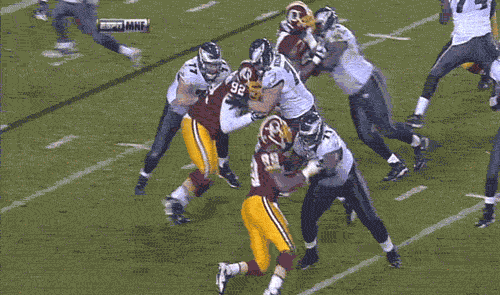 Fatigue in the NFL is definitely real, and a team that’s tired is not a team that’s likely to excel. But I don’t know if it’s even possible to accurately measure the effect of fatigue in the NFL, and if it is, I certainly don’t know how to do it. Fatigue is a useful descriptive term but one hard to define. Is playing 3 games in 11 days likely to lead to a fatigued team? What about traveling west to east for a 1:00 game? How does that compare to being on the field for 10 minutes? And how does that compare to playing opposite a defense that’s gone 3 and out on three straight drives?
Fatigue in the NFL is definitely real, and a team that’s tired is not a team that’s likely to excel. But I don’t know if it’s even possible to accurately measure the effect of fatigue in the NFL, and if it is, I certainly don’t know how to do it. Fatigue is a useful descriptive term but one hard to define. Is playing 3 games in 11 days likely to lead to a fatigued team? What about traveling west to east for a 1:00 game? How does that compare to being on the field for 10 minutes? And how does that compare to playing opposite a defense that’s gone 3 and out on three straight drives?
I don’t know. What I can do is look at the data we have from the last 12 years and see what general trends we can discern. So, are defenses worse off if they’ve been on the field for awhile?
There have been nearly 15,000 instances of teams having 1st and 10 near mid-field, defined as between the two 47 yard lines. On average, when teams gain possession in that area, they scored 2.2 points per drive. And, on average, those teams over the course of the season, averaged 1.75 points per drive over all drives.
So what happens if the “1st and 10 from the 47, 48, 49, 50, 49, 48, or 47” is the second play of the drive? Or the third? Or the 9th?
The 2.2 points per drive average when the situation occurs on the first play of the drive is the lowest in the group, although I don’t think that’s due to fatigue. Take a look:
| Play # | Pts/Drv | Avg PPD |
|---|---|---|
| 1 | 2.20 | 1.75 |
| 2 | 2.29 | 1.76 |
| 3 | 2.39 | 1.75 |
| 4 | 2.46 | 1.76 |
| 5 | 2.40 | 1.78 |
| 6 | 2.49 | 1.76 |
| 7 | 2.26 | 1.75 |
| 8 | 2.37 | 1.81 |
| 9+ | 2.34 | 1.75 |
The middle column shows how many points, on average, teams scored in that situation, while the far right column shows the quality of the offenses in general (not that it really matters in this case). If fatigue had an impact in this situation, you would see the teams that start at their own 20, take 6 or 7 plays, and then have 1st and 10 at midfield be very successful. But that’s not the case.
[continue reading…]
